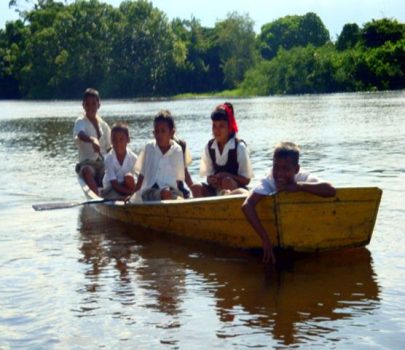How can anyone forget the magic
of that childhood realm called

where children can shout at the world
and run in delight from the returning echo,
or kick tomorrow’s cares over the nearest fence
or pelt stones at the forbidden fruit
of concupiscence, hanging low
near the garden wall—or tease
Miss Armstrong’s dogs behind their iron gate,
acquiring images of snarling teeth and saliva
to feature in future nightmares:
anything to help achieve that temporary loss
of time and destination and to enjoy
excursions into worlds beyond the boundaries
of prudence and parental expectation…
This group of home-bound scholars
drives their boat stern-first down
the Pomeroon river: the young steersman
propped in the narrow bow while
one dreaming schoolboy passenger
is sprawled prone in the wide stern,
hand dangling in the water,
face wreathed in the smiling joy
of one who has long tamed sun and river,
has given up paddle and purpose
because he understands that the boat,
the paddlers, the books and the homework questions
will eventually sail into the safe port
of home with its parental sigh of relief…
And everyone knows that those parents
—and the whole wide world—
will ensure that, one responsible day in the future,
he will paddle his boat swift and straight
into the adult world of care and consequences…
but until then, let the schoolboy’s happy smile
echo the wonder of mid-afternoon light
dancing on the sun-lit river…
—Mark McWatt
25th October, 2013.
The poet Mark McWatt explains: “The photograph was taken in September, 2009, a few weeks after the new school year began. I immediately understood that the attitude of the paddlers and their stern-first movement down the river were part of that childhood rebelliousness in which we all participated: whether we strayed from the straight path home, tried dangerous manoeuvres on our bikes, or stopped on the way to play games or chat with girls… Remembering my own schoolboy experiences, it was hard not to feel a bit of wistful envy at the mode of transportation entrusted to these youngsters…”
This is one example of McWatt’s collection of Picture Poems, a unique volume of work that he has recently compiled. “…Over the past few years I’ve been writing poems based on, or inspired by, photographs which I’ve taken—especially here in Barbados, where I live, but also in Guyana, Canada and other places to which I travel. I call these ‘picture-poems’; some are serious poems while others are lighter, humorous pieces.”

(For John and Coleen Carpenter)
Group of school children paddling home at mid-afternoon on the Pomeroon River.
(Photo by Mark McWatt, 2009)
Guyana has just ended the month of September dedicated to Amerindian Heritage. During this time every year the presence and culture of the indigenous people of the country are highlighted and celebrated in a variety of ways. In reflection of this we turn to poetry and other forms of literature through which these identities are infinitely expressed. Post-colonial considerations remember old pastoral and discredited relics like Sir John Squire’s “There Was An Indian” of purely historical regional significance, and in stark contrast to it, Bob Stewart’s post-colonial “Christopher Columbus”.
Among Guyanese poets there is no shortage of worthy candidates for deep interrogation of the indigenous heritage. A J Seymour has explored it in a short poem like “Shaman”, in his most famous piece – the sonnet “There Runs A Dream”, and in longer heroic verses. Ian McDonald and McWatt are among poets who are preoccupied with the interior, its landscape and its shadows, and have produced a corpus of work that speaks to these interests in the national identity.
The Seymour sonnet has flown far and prompted a comment from Eddie Baugh about the poet’s romantic approach to history in his summary of Dutch heritage, of slavery, the forests and rivers. It does not belong with post-colonialism, but includes reference to the “strong and quiet men” who “drove back a jungle”. Seymour writes of the inland waterways and the myths and legends that immortalise them. The Kaieteur Falls stands out along with the people who have named and revered them. “The Legend of Kaieteur” is the well-known long narrative poem of epic proportions dramatising a story of how the famous falls got its name. The heroic tale of Kai, the saviour of his people, is in stark contrast to the story collected by Barrington Brown, which has nothing resembling heroism. Yet it captures some of the mystery and spiritualism that still surround the mighty waterfall.
McWatt remains the poet with the most profound and wide-ranging treatment of the Amerindian presence in poetry about their environment and their cultural impact on it. He moves from the deeply metaphysical to a “picture poem” like “Pomeroon: Paddling Home After School”. This one has strong traces of the pastoral in its kind of idealistic setting of children in a playful, natural world. It is a poem of childhood as much as it is one of a normal Amerindian way of life in modern contemporary times. It contemplates that environment and is even playful and light-hearted in its ironic theme of a carefree existence against the issue of responsibility.
We have often seen these children paddling small boats on the Pomeroon, and have always harboured thoughts of a dangerous or danger-filled existence, of the hardship of having to row a boat for miles daily to and from school. But perhaps those superfluous anxieties were born out of familiarity to an overprotected norm of being ferried behind the rolled-up windows of a car to and from school daily. These ‘hardships’ in a daily life of ‘dangerous exposure’ to the ‘threatening’ river are looked back to by the poet with a nostalgic wish to return to the joyous idyllic life.
The picture poem gives us a realistic reflection of Amerindian culture – a delightful image of Guyana.





